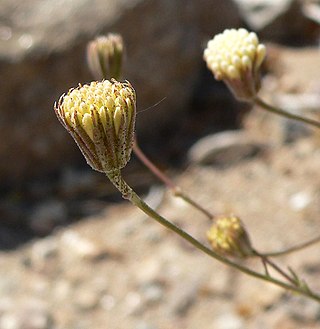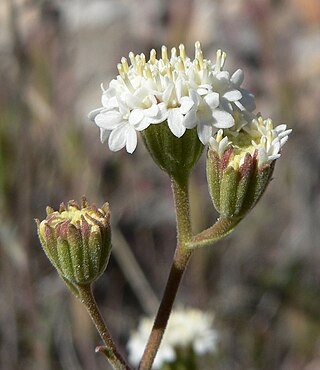
Chaenactis xantiana, the Mojave pincushion or Xantus pincushion, is a flowering plant in the family Asteraceae, native to the western United States, from southeastern Oregon, Nevada, southern and eastern California and northwestern Arizona. It is very common in the Antelope Valley in the Mojave Desert, and grows in sandy soils.

Chaenactis is a genus of plants in the family Asteraceae which are known generally as pincushions and dustymaidens.

Chaenactis fremontii, with the common names Frémont's pincushion and desert pincushion, is a species of annual wildflower in the daisy family. Both the latter common name, and the specific epithet are chosen in honor of John C. Frémont.

Helianthus cusickii is a species of sunflower known by the common names Cusick's sunflower and turniproot sunflower. It is native to the western United States from Washington, Oregon, Idaho, northern California, and northwestern Nevada.

Hymenoxys lemmonii is a species of flowering plant in the daisy family known by the common names Lemmon's rubberweed, Lemmon's bitterweed, and alkali hymenoxys. It is native to the western United States in and around the Great Basin in Utah, Nevada, northern California, and southeastern Oregon.

Chaenactis artemisiifolia, with the common name white pincushion, is a species of flowering plant in the daisy family. It is native to the coastal Peninsular Ranges of Southern California and Baja California, in the chaparral and woodlands.
Chaenactis alpigena is a species of flowering plant in the daisy family known by the common name southern Sierra pincushion. It is native to the High Sierra Nevada and the White Mountains of California, extending in the latter just into Nevada.

Chaenactis carphoclinia is a species of flowering plant in the daisy family known by the common name pebble pincushion. It is native to the southwestern United States and northwestern Mexico, where it grows in rocky and gravelly habitat, such as the California deserts. The species is found in southern California, Nevada, Utah, Arizona, southwestern New Mexico, Baja California, Sonora.

Chaenactis douglasii is a North American species of flowering plant in the daisy family known by the common name Douglas' dustymaiden.

Chaenactis glabriuscula, with the common name yellow pincushion, is a species of flowering plant in the daisy family. It is native to California and Baja California.

Chaenactis macrantha is a species of flowering plant in the daisy family known by the common names bighead dustymaiden and Mojave pincushion. It is native to the Great Basin and the southwestern deserts of the United States, in California, Arizona, Utah, Nevada, southwestern Idaho, and southeastern Oregon. It grows in dry, open habitat with gravelly, sandy soils, often calcareous or alkaline in nature.

Chaenactis stevioides, with the common names Esteve's pincushion and desert pincushion, is a species of flowering plant in the daisy family. It is also sometimes called false yarrow or broad-leaved Chaenactis.
Crepis bakeri is a species of flowering plant in the family Asteraceae known by the common name Baker's hawksbeard. It is native to the western United States where it grows in many types of mountain and plateau habitat. It is found in Oregon, Washington, Idaho, northern California, Nevada, and Utah.

Chaenactis suffrutescens is a species of flowering plant in the aster family known by the common name Shasta chaenactis.

Erigeron petrophilus is a species of flowering plant in the family Asteraceae known by the common names rockloving erigeron or cliff fleabane. It is native to the mountain ranges of California from Siskiyou County south as far as San Luis Obispo County and El Dorado County. It also grows in southwestern Oregon.

Centromadia fitchii, common name Fitch's spikeweed or Fitch's tarweed, is a species of North American plants in the tribe Madieae within the family Asteraceae. It is native to California and southwestern Oregon.

Chaenactis thompsonii is a North American species of flowering plants in the aster family known by the common name Thompson's pincushion and native to Washington State.
Chaenactis nevii is a North American species of flowering plants in the aster family known by the common name John Day pincushion. It is found only in the John Day Basin area in the US State of Oregon.
Chaenactis evermannii is a North American species of flowering plants in the aster family known by the common name Evermann's pincushion. It is found only at high altitudes in the mountains in the central part of the US State of Idaho.

Eucephalus ledophyllus is a North American species of flowering plant in the family Asteraceae known by the common name Cascade aster. It is native to Washington, Oregon and northern California in the United States, mostly in the Cascade Mountains. Some of the populations are inside national parks and monuments: Mount Rainier National Park, North Cascades National Park, and Mount St. Helens National Volcanic Monument.















